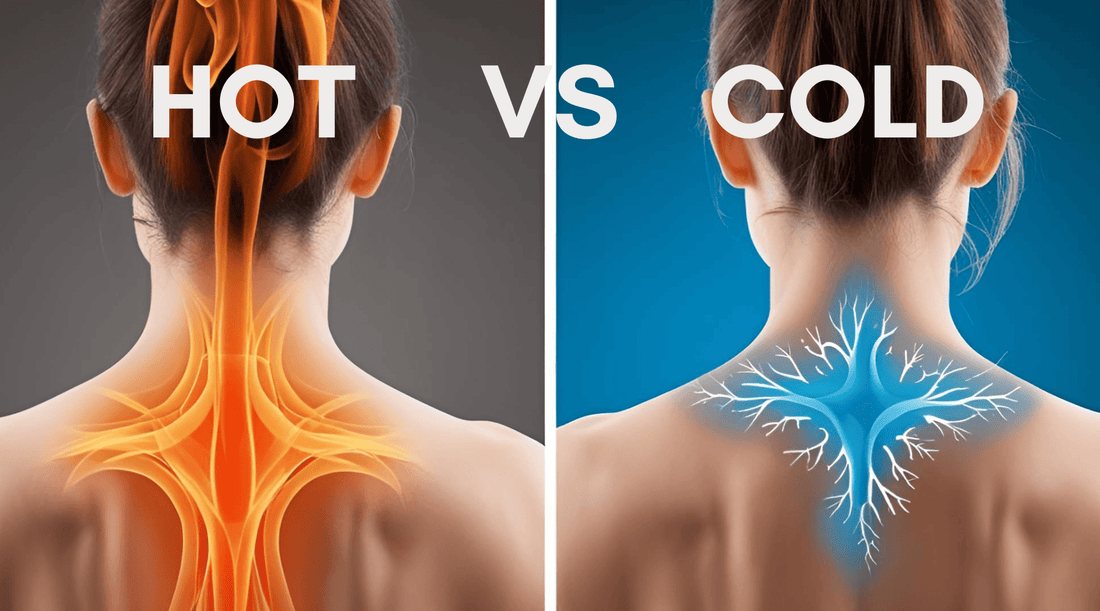
Cold vs. Heat Therapy for Muscle Pain Relief: Pros, Cons, and When to Use Each
Share
Cold vs. Heat Therapy: Which One is Better for Sore Muscles?
When muscle pain strikes, one of the first questions that comes to mind is: Should I use heat therapy or cold therapy? This is a common concern, especially for those dealing with muscle soreness, inflammation, or stiffness.
Both cold and heat treatments have unique benefits, but knowing when to use each one can make a significant difference in your recovery process.
Cold Therapy: Best for New Injuries
Cold therapy (also known as cryotherapy) involves applying ice or a cold compress to an affected area to reduce inflammation, numb pain, and decrease swelling. It’s most effective when used immediately after an injury, such as a sprained ankle, muscle strain, or post-workout soreness.
Cold therapy works by constricting blood vessels, which limits blood flow to the affected area, reducing inflammation and swelling. It also slows down nerve activity, providing instant pain relief without the use of medication. By controlling inflammation early, cold therapy helps prevent long-term damage to muscles and joints.
Photo by Jan Antonin Kolar on Unsplash
How Cold Therapy Works
Cold therapy works by utilizing the body's natural response to extreme temperatures. When exposed to cold, blood vessels constrict, which reduces blood flow to the area and decreases swelling. The numbing effect also blocks pain signals, providing temporary pain relief.
The reduction in blood flow helps to limit inflammation and prevent excessive fluid buildup in tissues, which can cause prolonged swelling and discomfort.
When to Use Cold Therapy
Cold therapy is most effective when used in the following situations:
- Treating fresh injuries like sprains, strains, and bruises (within the first 48 hours)
- Preventing muscle soreness after intense exercise or physical activity
- Managing inflammatory conditions like tendonitis and bursitis
- Reducing swelling after surgeries or injuries
However, cold therapy should not be used if you have circulation issues, Raynaud’s disease, or numbness in the affected area, as it can exacerbate these conditions.
Looking for natural ways to apply cold therapy? Try these plant-powered remedies and cooling salves that support muscle recovery without synthetic ingredients.
Heat Therapy: Best for Stiff, Achy Muscles
Heat therapy, in contrast to cold therapy, involves applying heat to the body to increase blood flow, relax tight muscles, and improve flexibility. It’s ideal for managing chronic muscle pain, stiffness, and joint discomfort, as well as preparing muscles for exercise or relieving cramps.
Heat therapy helps expand blood vessels, increasing the flow of oxygen and nutrients to the affected area. This speeds up the healing process and relaxes tense muscles. It’s also great for soothing chronic conditions like arthritis or muscle knots.
How Heat Therapy Works
Heat therapy works by expanding blood vessels, allowing increased circulation to the muscles and tissues. This improves the supply of oxygen and nutrients, which accelerates the body’s natural healing process.
By relaxing tight muscles, heat therapy can help alleviate stiffness and improve mobility. It also helps to relieve cramping and muscle spasms by encouraging muscle relaxation.
When to Use Heat Therapy
Heat therapy is most beneficial in the following cases:
- Managing chronic muscle pain, stiffness, and joint discomfort
- Loosening tight muscles before exercise, such as stretching before a workout
- Relieving menstrual cramps, tension headaches, or lower back pain
- Soothing muscle spasms and providing relaxation for general muscle soreness
However, heat should not be applied to new injuries or areas that are inflamed, as it can exacerbate swelling. It's also important to avoid heat therapy if you have a fever or infection in the affected area.
Cold vs. Heat Therapy: Which One Should You Choose?
The best therapy depends on the type of pain or injury you’re experiencing. Here’s a simple guide to help you determine which therapy to use:
| Condition | Cold Therapy | Heat Therapy |
|---|---|---|
| Sprains & Strains | ✅ Best option | ❌ Avoid |
| Muscle soreness (after exercise) | ✅ Best option | ❌ Avoid |
| Chronic stiffness & tightness | ❌ Avoid | ✅ Best option |
| Arthritis pain | ❌ Avoid | ✅ Best option |
| Post-surgical swelling | ✅ Best option | ❌ Avoid |
| Tension headaches | ❌ Avoid | ✅ Best option |
How to Use Cold and Heat Therapy Together (Contrast Therapy)
In some cases, alternating between cold and heat therapy—known as contrast therapy can provide the best results. This method combines the benefits of both treatments, reducing inflammation while improving circulation and muscle relaxation.
How it works:
- Start with cold therapy by applying an ice pack for 10-15 minutes to reduce swelling and numb pain.
- Switch to heat therapy by applying a heating pad for 10-15 minutes to relax muscles and increase blood flow.
- Repeat the cycle for 30-60 minutes, depending on your comfort level.
Contrast therapy can help manage long-term injuries where inflammation has subsided. It can also be used to improve circulation and speed up recovery from chronic muscle tension or pain.
Final Thoughts: Choosing the Right Therapy for Your Muscles
When deciding whether to use heat or cold therapy, it’s important to consider the type of injury or pain you’re experiencing. Cold therapy is best for new injuries, inflammation, and acute pain, while heat therapy excels in relieving chronic muscle tension, stiffness, and discomfort. Contrast therapy offers a combination of both therapies, allowing you to benefit from the best of both worlds.
Always listen to your body, and if pain persists or worsens, don’t hesitate to consult a healthcare professional. They can provide guidance on which therapy will best suit your needs.






